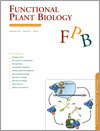
Functional Plant Biology
Volume 39 Number 9 2012
FP12116A critical review of translation initiation factor eIF2α kinases in plants – regulating protein synthesis during stress
Managing environmental stress is crucial for all living beings, including plants. An important mammalian response to stress results in protein synthesis inhibition while the cell overcomes the cause of the stress; this same pathway appears to be present in plants. Methods to assist plants overcome various abiotic and biotic stresses may be revealed by understanding how this pathway functions, resulting in more robust plants that have greater crop yields.
FP12106Four AUXIN RESPONSE FACTOR genes downregulated by microRNA167 are associated with growth and development in Oryza sativa
Plant microRNAs have been demonstrated to be indispensable regulators for normal growth and development. Our aim in this study was to explore the molecular basis of microRNA functions in rice; the results showed that the post-transcriptional regulation of four auxin-responsive genes by miR167 is important especially for rice reproductive development. These findings broaden our understanding of the regulatory roles of miR167 during rice growth and development.
FP12132Delaying Riesling grape berry ripening with a synthetic auxin affects malic acid metabolism and sugar accumulation, and alters wine sensory characters
Understanding the hormonal control of grape berry ripening, and having an ability to manipulate it, is of interest scientifically and commercially. Auxin treatment before ripening delayed ripening and harvest, increased ripening synchronicity and altered wine metabolites and flavour. This demonstrates the involvement of auxins in controlling ripening, and their potential for controlling winery intake and fruit and wine composition.
FP12093Histological and molecular investigation of the basis for variation in tomato fruit size in response to fruit load and genotype
Understanding how assimilate supply and genotypic factors cause variation in fruit size is critical in the control of fruit growth. Our results indicate that the timing of assimilate supplied to the fruit affects the relative contribution of cell number and cell volume to the genotypic variation in fruit size, suggesting a link between fruit sugar content and genotypic variation in fruit and cell characteristics. With these results we improve the understanding of the physiological mechanisms that explain genotypic and assimilate-induced variation in fruit size.
FP12051Aberrant promoter methylation occurred from multicopy transgene and SU(VAR)3–9 homolog 9 (SUVH9) gene in transgenic Nicotiana benthamiana
Understanding and utilising epigenetic gene silencing in genetic modification (GM) of crops is critical for the future development and commercialisation of transgenic crops. This study describes the correlation of homology-dependent gene-silencing (HDGS)-related genes and unexpected gene-silencing events through T7 to T8 generations of transgenic plants. This work provides considerable factors for stable transgene expression and heritability in GM crops.
FP12068Geographically distinct Ceratophyllum demersum populations differ in growth, photosynthetic responses and phenotypic plasticity to nitrogen availability
Introduced aquatic plants often outcompete native species in lakes in introduced ranges. We studied how two geographically distinct populations of Ceratophyllum demersum, which is invasive in New Zealand but not in Denmark, respond to nitrogen. The NZ population had pronounced invasive traits, such as high growth and photosynthetic rates, more so than the DK population. Hence, two populations of the same species can be different when grown under similar conditions.
FP12159Two sympatric root hemiparasitic Pedicularis species differ in host dependency and selectivity under phosphorus limitation
Parasitic biology of Pedicularis species has been underinvestigated despite its potential ecological significance and wide distribution in the northern hemisphere. We investigated two sympatric Pedicularis species from SW China and found that the species have different patterns of host–parasite interactions in pot experiments. Our findings suggest that sympatric Pedicularis may have differential influence on plant community structure and productivity and hence, caution must be taken in generalising consequences of host–parasite interactions.
FP12129Supplying nitrate before bud break induces pronounced changes in nitrogen nutrition and growth of young poplars
Young poplars (Populus tremula L. × Populus alba L.) were found to take up nitrate before bud break, which lead quickly to significant changes on regrowth and N partitioning of sinks just after bud break. The N uptake increased the quality of new shoots. The uptake of N by the poplar scions before bud break amounted to approximately a third of the N storage of the previous year. After bud break, emerging leaves restarted the sap flow, which increased nitrate uptake to support the regrowth. These results show that early N supply plays a significant role in the N status and N remobilisation involved in the spring re-growth of young trees. Our study applies to tree nurseries where growth of young trees may be stimulated by the addition of fertilizers just before bud break and during spring regrowth, rather than applying fertilizers in autumn.
FP12070Hydraulic lift promotes selective root foraging in nutrient-rich soil patches
The extra moisture provided through Hydraulic lift (HL) – the passive movement of water from deep wet to shallow drier soil layers through plant roots – may improve root growth and enhance nutrient capture during drought. Root foraging precision and plant nitrogen capture was greater in shrubs engaged in HL, suggesting that HL indirectly favoured root foraging in nutrient-rich patches enhancing nutrient capture. To our knowledge, this is the first time that HL has been linked to both root foraging and nutrient capture, therefore, showing that HL is a process that secures plant performance during drought.



